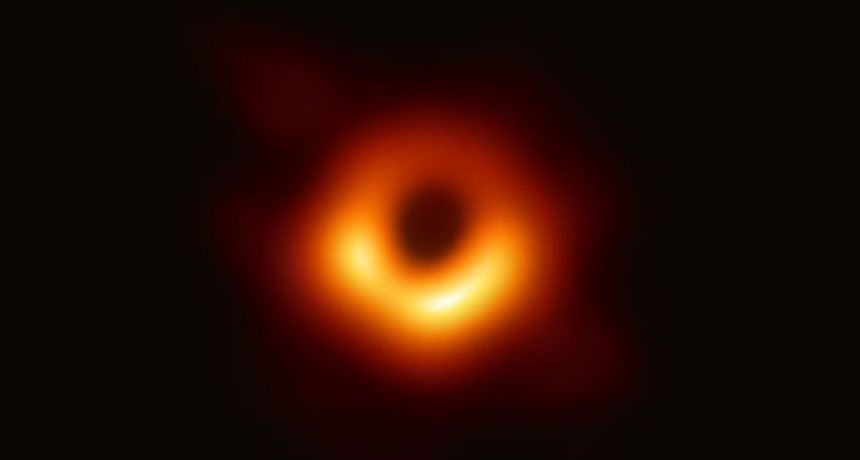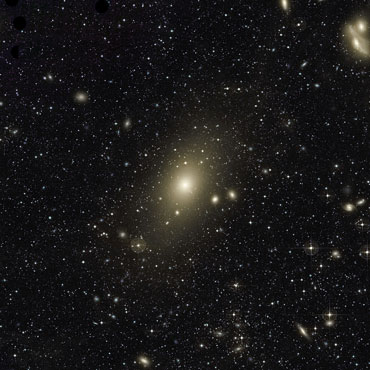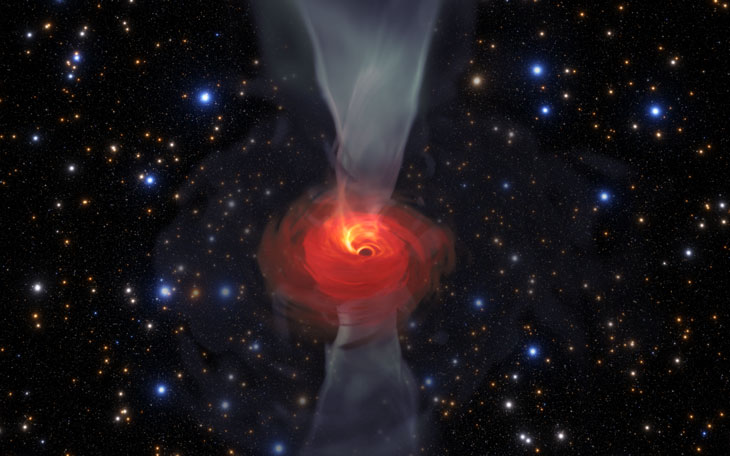Here’s the first picture of a black hole
The supermassive beast lies some 55 million light-years away in a galaxy called M87

The first image of a black hole shows a bright ring with a dark, central spot. That ring is a bright disk of gas orbiting the supermassive behemoth in the galaxy M87. The spot is the black hole’s shadow.
This is what a black hole looks like.
A black hole isn’t really a hole. It’s an object in space with incredible mass packed into a very small area. All that mass creates such a huge gravitational tug that nothing can escape a black hole, including light.
The newly imaged supermassive monster lies in a galaxy called M87. A world-spanning network of observatories called the Event Horizon Telescope, or EHT, zoomed in on M87 to create this first-ever picture of a black hole.
“We have seen what we thought was unseeable,” Sheperd Doeleman said April 10 in Washington, D.C. “We have seen and taken a picture of a black hole,” he reported at one of seven concurrent news conferences. Doeleman is EHT’s director. He also is an astrophysicist at the Harvard-Smithsonian Center for Astrophysics in Cambridge, Mass. Results from his team’s work appear in six papers in the Astrophysical Journal Letters.
The concept of a black hole was first hinted at back in the 1780s. The mathematics behind them came from Albert Einstein’s 1915 general theory of relativity. And the phenomenon got its name “black hole” in the 1960s. But until now, all “pictures” of black holes have been illustrations or simulations.
“We’ve been studying black holes so long, sometimes it’s easy to forget that none of us have actually seen one.”
— France Córdova, director of the National Science Foundation
“We’ve been studying black holes so long, sometimes it’s easy to forget that none of us have actually seen one,” France Córdova said in the Washington, D.C., news conference. She is director of the National Science Foundation. Seeing a black hole “is a Herculean task,” she said.

The galaxy M87 sits about 55 million light-years from Earth in the constellation Virgo. Unlike the Milky Way’s stunning spirals, M87 is a blobby giant elliptical galaxy. The Event Horizon Telescope just took the first image of the black hole at the center of M87.
CHRIS MIHOS/CASE WESTERN RESERVE UNIV., ESO
That’s because black holes are famously hard to see. Their gravity is so extreme that nothing, not even light, can escape across the boundary at a black hole’s edge. That edge is known as the event horizon. But some black holes, especially supermassive ones dwelling in galaxies’ centers, stand out. They gather bright disks of gas and other material that surrounds the black hole. The EHT image reveals the shadow of M87’s black hole on its accretion disk. That disk looks like a fuzzy, asymmetrical ring. It unveils for the first time the dark abyss of one of the universe’s most mysterious objects.
“It’s been such a buildup,” Doeleman said. “It was just astonishment and wonder… to know that you’ve uncovered a part of the universe that was off limits to us.”
The much-anticipated big reveal of the image “lives up to the hype, that’s for sure,” says Priyamvada Natarajan. This astrophysicist at Yale University, in New Haven, Conn., is not on the EHT team. “It really brings home how fortunate we are as a species at this particular time, with the capacity of the human mind to comprehend the universe, to have built all the science and technology to make it happen.”
Einstein was right
The new image aligns with what physicists expected a black hole to look like based on the theory of general relativity by Albert Einstein. That theory predicts how spacetime is warped by the extreme mass of a black hole. The picture is “one more strong piece of evidence supporting the existence of black holes. And that, of course, helps verify general relativity,” says Clifford Will. He’s a physicist at the University of Florida in Gainesville, who is not on the EHT team. “Being able to actually see this shadow and to detect it is a tremendous first step.”
Studies in the past have tested general relativity by looking at the motions of stars or gas clouds near a black hole, but never at its edge. “It’s as good as it gets,” Will says. Tiptoe any closer and you’d be inside the black hole. And then you’d be unable to report back on the results of any experiments.
“Black hole environments are a likely place where general relativity would break down,” says EHT team member Feryal Özel. She is an astrophysicist who works at the University of Arizona in Tucson. So testing general relativity in such extreme conditions could reveal things that don’t seem to support Einstein’s predictions.
Explainer: Quantum is the world of the super small
However, she adds, just because this first image upholds general relativity “doesn’t mean general relativity is completely fine.” Many physicists think that general relativity won’t be the last word on gravity. That’s because it’s incompatible with another essential physics theory, quantum mechanics. This theory describes physics on very small scales.
The new image provided a new measurement of the size and heft of M87’s black hole. “Our mass determination by just directly looking at the shadow has helped resolve a longstanding controversy,” Sera Markoff said in the Washington, D.C., news conference. She’s a theoretical astrophysicist at the University of Amsterdam in the Netherlands. Estimates made using different techniques have ranged between 3.5 billion and 7.22 billion times the mass of the sun. New EHT measurements show that the mass of this black hole is about 6.5 billion solar masses.
The team also has figured out the behemoth’s size. Its diameter stretches 38 billion kilometers (24 billion miles). And the black hole spins clockwise. “M87 is a monster even by supermassive black hole standards,” Markoff said.
Scientists have been speculating for years about what a black hole would actually look like. Now, they finally know the answer.
Looking ahead
EHT trained its sights on both M87’s black hole and Sagittarius A*. That second supermassive black hole sits at the center of our galaxy, the Milky Way. But, the scientists found it easier to image M87’s monster, even though it’s about 2,000 times as far away as Sgr A*.
M87’s black hole sits about 55 million light-years from Earth in the constellation Virgo. But it’s also about 1,000 times as massive as the Milky Way’s giant. Sgr A* only weighs the equivalent of roughly 4 million suns. M87’s extra heft nearly compensates for its greater distance. The size it covers in our sky “is pretty darn similar,” says EHT team member Özel.
Because M87’s black hole is bigger and has more gravity, gases swirling around it move and vary in brightness more slowly than they do around Sgr A*. And here’s why that’s important. “During a single observation, Sgr A* doesn’t sit still, whereas M87 does,” says Özel. “Just based on this ‘Does the black hole sit still and pose for me?’ point of view, we knew M87 would cooperate more.”
With more data analysis, the team hopes to solve some long-standing mysteries about black holes. These include how M87’s black hole spews such a bright jet of charged particles many thousands of light-years into space.

Some black holes launch jets of charged particles thousands of light-years into space, such as the one shown in this image from a simulation. Data collected to create the first image of a black hole, the one in galaxy M87, may help reveal how these jets are produced.
Some black holes launch jets of charged particles thousands of light-years into space, such as the one shown in this image from a simulation. Data collected to create the first image of a black hole, the one in galaxy M87, may help reveal how these jets are produced.
Power Words
More About Power Words
align (noun: alignment) To place or organize things in a patterned order, following an apparent line.
astrophysics An area of astronomy that deals with understanding the physical nature of stars and other objects in space. People who work in this field are known as astrophysicists.
behemoth A term for anything that is amazingly big. The term comes from a monstrous animal described in the Bible’s book of Job.
black hole A region of space having a gravitational field so intense that no matter or radiation (including light) can escape.
consortium A group or association of independent organizations.
constellation Patterns formed by prominent stars that lie close to each other in the night sky. Modern astronomers divide the sky into 88 constellations, 12 of which (known as the zodiac) lie along the sun’s path through the sky over the course of a year. Cancri, the original Greek name for the constellation Cancer, is one of those 12 zodiac constellations.
diameter The length of a straight line that runs through the center of a circle or spherical object, starting at the edge on one side and ending at the edge on the far side.
event horizon An imaginary sphere that surrounds a black hole. The more massive the black hole, the bigger the sphere. Anything that happens inside the event horizon is invisible, because gravity is so strong that under normal circumstances even light can’t escape. But according to some theories of physics, in certain situations small amounts of radiation can escape.
galaxy A massive group of stars bound together by gravity. Galaxies, which each typically include between 10 million and 100 trillion stars, also include clouds of gas, dust and the remnants of exploded stars.
gravity The force that attracts anything with mass, or bulk, toward any other thing with mass. The more mass that something has, the greater its gravity.
light-year The distance light travels in one year, about 9.48 trillion kilometers (almost 6 trillion miles). To get some idea of this length, imagine a rope long enough to wrap around the Earth. It would be a little over 40,000 kilometers (24,900 miles) long. Lay it out straight. Now lay another 236 million more that are the same length, end-to-end, right after the first. The total distance they now span would equal one light-year.
mass A number that shows how much an object resists speeding up and slowing down — basically a measure of how much matter that object is made from.
mechanics The study of how things move.
Milky Way The galaxy in which Earth’s solar system resides.
National Science Foundation The U.S. Congress created this independent federal agency in 1950 to promote the advancement of science; national health, prosperity and welfare; and the nation’s defense. This agency funds nearly one-fourth of all federally supported basic research in U.S. colleges and universities. In many fields such as mathematics, computer science and the social sciences, NSF is the major source of federal funding.
network A group of interconnected people or things. (v.) The act of connecting with other people who work in a given area or do similar thing (such as artists, business leaders or medical-support groups), often by going to gatherings where such people would be expected, and then chatting them up. (n. networking)
observatory (in astronomy) The building or structure (such as a satellite) that houses one or more telescopes.
particle A minute amount of something.
physics The scientific study of the nature and properties of matter and energy. Classical physics is an explanation of the nature and properties of matter and energy that relies on descriptions such as Newton’s laws of motion. Quantum physics, a field of study that emerged later, is a more accurate way of explaining the motions and behavior of matter. A scientist who works in such areas is known as a physicist.
quantum (pl. quanta) A term that refers to the smallest amount of anything, especially of energy or subatomic mass.
quantum mechanics A branch of physics dealing with the behavior of matter on the scale of atoms or subatomic particles.
relativity (in physics) A theory developed by physicist Albert Einstein showing that neither space nor time are constant, but instead affected by one’s velocity and the mass of things in your vicinity.
spacetime A term made essential by Einstein’s theory of relativity, it describes a designation for some spot given in terms of its three-dimensional coordinates in space, along with a fourth coordinate corresponding to time.
standards (in research) The values or materials used as benchmarks against which other things can be compared.
star The basic building block from which galaxies are made. Stars develop when gravity compacts clouds of gas. When they become dense enough to sustain nuclear-fusion reactions, stars will emit light and sometimes other forms of electromagnetic radiation. The sun is our closest star.
sun The star at the center of Earth’s solar system. It’s an average size star about 26,000 light-years from the center of the Milky Way galaxy. Also a term for any sunlike star.
telescope Usually a light-collecting instrument that makes distant objects appear nearer through the use of lenses or a combination of curved mirrors and lenses. Some, however, collect radio emissions (energy from a different portion of the electromagnetic spectrum) through a network of antennas.
theoretical An adjective for an analysis or assessment of something that based on pre-existing knowledge of how things behave. It is not based on experimental trials. Theoretical research tends to use math — usually performed by computers — to predict how or what will occur for some specified series of conditions. Experimental testing or observations of natural systems will then be needed to confirm what had been predicted.
theory (in science) A description of some aspect of the natural world based on extensive observations, tests and reason. A theory can also be a way of organizing a broad body of knowledge that applies in a broad range of circumstances to explain what will happen. Unlike the common definition of theory, a theory in science is not just a hunch. Ideas or conclusions that are based on a theory — and not yet on firm data or observations — are referred to as theoretical. Scientists who use mathematics and/or existing data to project what might happen in new situations are known as theorists.
universe The entire cosmos: All things that exist throughout space and time. It has been expanding since its formation during an event known as the Big Bang, some 13.8 billion years ago (give or take a few hundred million years).
verify (n. verification) To demonstrate or confirm in some way that a particular claim or suspicion is true.
weather Conditions in the atmosphere at a localized place and a particular time. It is usually described in terms of particular features, such as air pressure, humidity, moisture, any precipitation (rain, snow or ice), temperature and wind speed. Weather constitutes the actual conditions that occur at any time and place. It’s different from climate, which is a description of the conditions that tend to occur in some general region during a particular month or season.
https://www.sciencenewsforstudents.org/article/black-hole-first-photo-event-horizon-telescope

